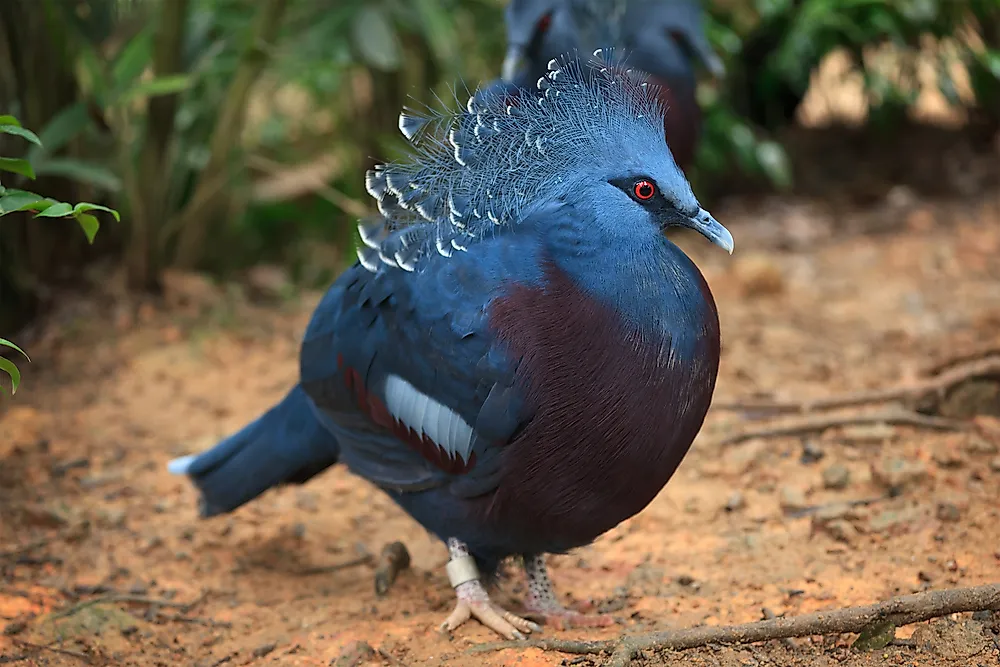The Victoria crowned pigeon (Goura victoria) is a magnificent and sizeable bluish-grey pigeon native to the New Guinea region. Its appearance is adorned with exquisite blue lace-like crests, a maroon breast, and striking red irises. Belonging to the Goura genus, it is one of four distinctive, large ground-dwelling pigeons found in this area. This bird stands out with its distinctive white-tipped crests and emits deep ‘whooping’ sounds during its calls. Notably, it was named in honor of Queen Victoria, the British monarch.
Appearance

The Victoria crowned pigeon is a large, bluish-grey bird adorned with elegant blue lace-like crests, a maroon breast, and captivating red eyes. Belonging to the Goura genus, it is one of four unique, ground-dwelling pigeons native to the New Guinea region. Its white-tipped crests and deep ‘whooping’ calls make it easily recognizable.
Distribution
In terms of distribution, Victoria crowned pigeons are found in northern New Guinea, surrounding islands, and certain regions of Indonesia. They predominantly inhabit lowland moist and swamp forests, often favoring areas that were once alluvial plains, including sago forests. This striking species enriches the diverse biodiversity of the Australasian and Indomalayan biogeographical realms, thriving in the lush environments of tropical moist forests in Oceania and Southeast Asia.
Habits and Lifestyle
Victoria crowned pigeons are sociable creatures, often seen traveling in pairs or small groups while foraging for food. They exhibit a calm and unhurried gait as they stroll along the forest floor. These birds are predominantly terrestrial, spending the majority of their time on the ground. However, when disturbed or during nighttime, they take to the trees for roosting.
When startled, the pigeons rapidly ascend into the canopy or a substantial horizontal branch of a large forest tree. After such disturbances, they may linger on their perch, using contact calls and flicking their tails. Males engage in regular aggressive displays to establish dominance, puffing up their chests and repeatedly raising their wings, as if preparing to strike their rival. While these interactions appear intense, they seldom result in actual contact, and outside of the mating season, they can be peaceful towards other males.
Victoria crowned pigeons employ a variety of calls for communication. Their contact call is deep and muffled, resembling a human-like ‘ummm’ or ‘hmmm.’ A loud clapping sound accompanies their take-off during flight, while their mating calls consist of a deep ‘hoota-hoota-hoota-hoota-hoota’ sound. When defending their territories, they emit a resounding ‘whup-up, whup-up, whup-up’ call.
Diet and Nutrition

Victoria crowned pigeons are primarily herbivores, with a diet consisting of fruits, berries, and seeds. They primarily feed on fallen fruits but also supplement their diet with other plant-based foods. Occasionally, they may consume small invertebrates.
Mating Habits

Victoria crowned pigeons are monogamous birds, forming lifelong partnerships with their mates. Their breeding season peaks late in the wet season and again during the dry season. During courtship, the male displays for the female by lowering his head, stretching forward, and rhythmically swinging his head up and down while wagging his fanned tail.
Nesting and Reproduction: The female, referred to as the “hen,” usually lays a single white egg in a well-built tree nest made of stems, sticks, and palm leaves. In the weeks leading up to egg-laying, the male provides nesting materials to the female. The incubation period for the egg is around 30 days.
The chicks hatch in an altricial state, meaning they are helpless, blind, and dependent on parental care. Although the female does most of the direct brooding, both parents actively participate in raising the young. The chicks leave the nest when they are still much smaller than their parents but are closely tended to for a total of 13 weeks. They reach reproductive maturity at around fifteen months of age, continuing the cycle of monogamous breeding behavior in this magnificent species.
Population
Population threats
The Victoria crowned pigeon is now the most rarely occurring of the three crowned pigeon species in the wild, although it is the most widely kept species in captivity. Perhaps the most pressing threat to the species is continuing habitat loss due to logging. It now quite uncommon near human habitations because it is heavily hunted around them, particularly in areas where gun possession is prevalent. It can be quite tame and easily shot, though now seems to be fearful of humans in the wild. Most hunting is for its plumes and meat.

Population number
According to the IUCN Red List, the total population size of the Victoria crowned pigeon is around 10,000-20,000 individuals. Currently, this species is classified as Near Threatened (NT) on the IUCN Red List and its numbers today are decreasing.
